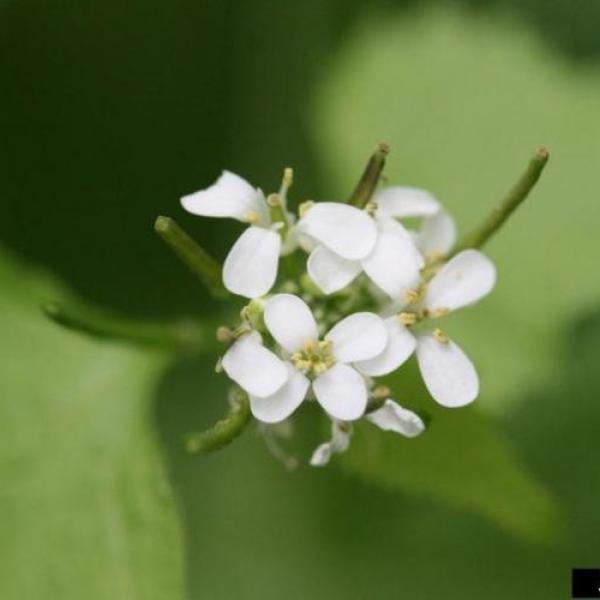
Written by: Lina Swislocki, VT FPR
Garlic mustard (Alliaria petiolata) is an invasive herbaceous biennial plant. It is thought to have originated in Europe where it was historically grown as food and medicine. It likely came to the Vermont region with colonizers in the 1600s – so long ago that many people don’t realize it didn’t evolve here – and has been widely seen in area woodlands since the late 1800s.
Garlic mustard has a dramatic negative impact on local ecology, affecting both plants and animals. It thrives in a variety of growing conditions (different soils, different light availability, etc.), so it can flourish easily and quickly in many locations. More dramatically, it is allelopathic, which means it can secrete toxins from its roots into the soil that inhibit the growth of other plant species. Thus, it is easy for garlic mustard to become established in a new area, and it is also easy for garlic mustard to completely take over eco-communities once it has become established. Obviously, this can be tremendously detrimental to the plants it has displaced.
Additionally, garlic mustard can have a huge influence on the animals that rely on the plants it displaces. One vivid example is the West Virginia White Butterfly (Pieris virginiensi). They are a small butterfly species from the forested regions of the eastern North America. They fly for about a month in early spring, sipping nectar and laying eggs – having evolved to lay their eggs on local toothwort species (Cardamine diphylla and Cardamine concatenata). While garlic mustard and toothwort are related, the invasive (garlic mustard) is outcompeting and displacing the local (toothwort) and these butterflies are lured into laying on garlic mustard. But garlic mustard makes a chemical (alliarinoside) in its leaves that toothwort does not make, and which is toxic to West Virginia White larvae. Thus, the butterflies lay their eggs on a plant that kills their caterpillars. Additionally, although garlic mustard does flower and produce a significant amount of nectar, it does so at the wrong time to be accessible to West Virginia White adults. The numbers have declined significantly and rapidly for the West Virginia White, and the presence and expansion of garlic mustard throughout the butterfly’s historic range is thought to have played a key role. The impact of West Virginia White decline on the rest of the ecosystem is unknown.
Garlic mustard has a two-year lifecycle. In its first year, it grows vaguely heart-shaped serrated leaves in a circular pattern called a basal rosette. These leaf clumps tend to be 4”-6” in diameter and 1”-3” tall. Some are able to overwinter under the Vermont snow. In its second year, garlic mustard bolts in the spring, sending up stalk usually 12”-24” tall (though plants as tall as 60” have been confirmed). The leaves become more triangular and move to an alternate pattern around the stem, and clumps of small, white, four-petaled flowers develop, usually in late April. Through late spring and early summer, the flowers progress to four-sided seedpods called siliques. On average, each plant makes 22 siliques, and each silique contains 28 small black seeds (about the size of sugar ants). The seeds generally germinate within 2 years, but can survive in the seedbank for up to 5 years. They are spread primarily by people and other animals transporting them to new locations.
Another good way to identify garlic mustard is its smell. When crushed, the leaves are pungent and reminiscent of garlic. They are edible – garlic mustard pesto is a popular recipe – and taste best before the plant has made flowers.
The best way to treat garlic mustard is to pull up second year plants by the roots before they make seeds. Put the plants in plastic bags and leave the closed bags in the sun where the plants were pulled (the heat inside the bag will ensure that the plants thoroughly decompose); after one year, the bags of sludge can be added to a compost pile. Transporting freshly pulled garlic mustard plants or putting it directly into compost piles that are not hot enough to fully decompose the plant risks spreading it further. As a last resort, if it cannot be managed on site, or your local compost facility cannot accept the material, the Vermont Department of Environmental Conservation states that you can double-bag, tie securely, and put it in the trash.
For more information on the biology and control of Garlic Mustard, check out VTinvasives.org and these additional resources:
- VT Quarantine and Watch List
- Nature Conservancy: Alliaria petiolata
- New York Invasive Species Information
- Pennsylvania DCNR Fact Sheet
- Michigan Department of Natural Resources Fact Sheet
- Ministry of the Environment, Conservation and Parks: West Virginia White Management Plan
- VT Center for Ecostudies: West Virginia White
- New York Natural Heritage Program: West Virginia White
Photo Credit: Chris Evans, University of Illinois, Bugwood.org